Week 3 in Italy
2017.01.15 Day 2 Week 3 Today was housekeeping, long walk, grocery shopping and visiting the Florence Academy of Art when Stefan and Lonnie Helgeson are studying for six weeks. In the afternoon I visited the Museo Stefano Bardini near where I live. From the museum’s own description: The museum is named after its creator, Stefano Bardini (1854-1922), the most authoritative Italian antiquarian, who, after years of intense business activity, decided to transform his collection into a museum and donate it to the Municipality of Florence. The palazzo where the museum is housed was bought and renovated by Bardini himself in 1881 so he could carry out his antique business. With some changes to the structure and the addition of some authentic architectural elements such as tympanums, portals and stairs, the antiquarian Bardini transformed the old building, once the church and convent of San Gregorio della Pace, into a charming neo-Renaissance palazzo suitable for housing not only the exhibition gallery but also a series of laboratories where the works of art were restored, ready to be sold. It will be fun to return to sketch the sculpture.
In the evening I did homework assignments and watched YouTube videos to better understand the gesture process.
2017.01.16 Day 3 Week 3 Class #6 Today was a packed day: lecture, Bargue drawing and figure drawing from a casting.
Bargue
We continued, on our 6th day of class, to refine our Bargue drawings. Even though I spent 5 hours on the shading last Saturday, I was not too surprised to find out that I am far from finished. I am learning both my few strengths and my many weakness. Among the prominent weaknesses that I have discovered are a) tendency to not double check diagonal relationships in the forms, b) through fatigue not see the obvious lack of “cleanness” in the shaded areas (cleanness is defined as uniformity), and c) overestimate my state of completeness. As I progressed through this first exercise these weaknesses are slowly be purged. Given that we are under no time limit, I tend to still operate as “time matters” which governed my professional life for 45 years. This weakness will, no doubt, take longer to deprogram. What did I learned today?
- Uniformity is crucial for the eye to read the form
- The transitions from one value to another are more important than the actual values
- Accurate scale relationships are essential. The eye can discern micro-measurement discrepancies and sense when a drawing is not in perfect proportions. You can not fool a good eye.
- Patience and a dedication to the craft of draughtsmanship is essential to a beautiful drawing.
- But in the end, it is not so much about draughtsmanship, technique or even accuracy. It is about the conveyance of life force.
Lecture Michael John Angel
Mid-morning we had a lecture on the connection of the shoulder girdle to the thorax (rib cage). The study of structural anatomy is about how to understand the groupings of structural elements that make forms or masses we see in painting. The arm muscles are attached to the scapula (shoulder blade)—which means that the shoulder is really an arm muscle. The only place the shoulder is connected to the body is through the clavicle at the pit of the neck. Each clavicle connects symmetrically at this “pit” or point. The tips of these bow shaped bones are separated by roughly 2 finger widths. The clavicle (or collar bone) forms a “cupid’s bow” shape when viewed symmetrically from the front. When viewing the figure form the side position, one of the shoulder blades will be seen frontally and the other will always be in profile. The shoulder blade is roughly the size of the palm of the hand (relatively small.) This “blade” also slides laterally along the rib cage when the arm is raised. The top of the shoulder blade is called the “spine”; the long leading edge is called the “medial border”; and the bottom point is referred to as “the interior angle.” These three points can be seen on the back and are critical referent points. When the hand is facing upward this referred to as “pronate” and when the back of the hand is up this is called “supinate”. When in the pronate position the arm is always facing inwards; when supinate it is always facing outwards. Learning these clues will help when studying your live model and enable you to be more accurate in the representations. The three main muscles attaching the shoulder blade to the arm are the infraspinatus, the teres major and minor. The valley between the infraspinatus and the teres major is one of the prominent visible lines on the back.
Figure Drawing
In the afternoon we began the journey to live figure drawing. We used a plaster cast of an archer whose muscles and bone structure were very prominent. This articulation enabled us to more easily understand the referent points as we sight measured the cast model. We used a knitting needle held in a particular way (nestled between the index and little finger to the interior and the middle and third finger to the outside.) We kept our arm locked and the needle vertical. This was crucial to enable us to ensure accurate measurements. Like our previous exercises where we transferred the print figure to the paper by “measurement” we found the main referent points and plotted them along the vertical 30cm plumb line drawn on the paper with 1/4 points delineated. This vertical line is incredibly important to ensure that we render the figure accurately. Once we established the “gesture cartoon” (along the side in an separate 8cm drawing) we then began work on the main drawing. As we know from the previous lesson, we established the torso, the feet, the knees, the hands and the that specific order. After we finished the gesture drawing (and was approved by our instructor) we began to construct, with straight lines, the major form of the figure. We established the major and minor turning points using only straight lines. Once this was approved, we mapped, again with straight lines, the major shadow areas. These were uniformly rendered in a number three value.
It was a long and intense day. It also snowed today; is very windy; and cold. So tonight I luxuriated in a warm carrot, squash and potato soup; and a simple salad of romaine lettuce, tomatoes and yellow pepper. The wine, a Chianti Montalbano “Tenuta di Montemagno” 2014, worked its magic.
2017.01.17 Day 4 Week 3 Class #7 We began our study of values by beginning a drawing of a value scale of 1-9. This exercise is our “warn up” for a few days and when complete will be used to help scale the values on our drawings. It will also help us understand the instructor’s reference to “place value 3 at the midpoint” for example. Our first assignment, following the value study, was to draw a new Bargue drawing in 60 minutes flat. We were not allowed to use a mechanical means to measure. All that was allowed was our sight and hands. I was assigned a guy that looks like he could be a Roman Senator. It was a great exercise. It taught me to a) get the contours down quickly, b) understand the key point alignments, c) trust my visual judgment and d) learn that adjustments after the major contours are established is easier than just trying to “get it right” from the beginning.
After this quick exercise we continued to refine our first “measured” Bargue drawing. It seems like we, as a group, could be finishing this first drawing in the next day or. I will post the “final” once our instructor approves it.
In the afternoon we had our last cast figure drawing class. Tomorrow we move onto a live model. We had 90 minutes for each pose—which were of the same cast model but from opposite sides. First, an 8 cm thumbnail was drawn to capture the gestures. Then, on the 30cm long plumb line, we began by drawing in a “sketchy-ghosty” line the contours (this is the term of art here at the Angel Academy of Art.) Once the major relationships were confirmed to be “accurate” (a relative term for this neophyte) we created the “construct” followed by the shadow contours shaded in a mid-value. Once the shadows were established, it was easier to “see” the mistakes. These were corrected. For me there a few consistent errors: a) feet too small, b) head too small, c) shoulders too high and d) lateral dimension too narrow.
In the evening I started an evening (9 weeks) anatomy class. I will report on this later.
2017.01.18 Day 5 Week 3 Class #8 My Bargue drawing was approved today. What did I learn: a) look very carefully for nuances, b) don’t rush, c) understand that tiny measurements mistakes telegraph into big mistakes, d) gradation of the light and shade demands very close scrutiny and e) make sure the setting our drawing is as accurate as possible.
In the afternoon we had our first live model session. This session reveals my many weaknesses. I am struggling with proportion and vertical alignment. I took an extra class tonight for 2 hours of short poses. I am hopeful with this extra class (9 sessions of 2 hours each) along with the regular figure drawing class that things will begin to click.

I was totally knackered when I got home. My feet hurt (standing 8 hours), hungry (late class) and I was anxious to do some reading after this blog post. So dinner was simple. I added onions, leeks and carrots to the premed soup base and that was it of the food. The wine was Notte Rossa Negroamaro from Salento. The rigor of 12 hour days and only a few breaks is both exhilarating and nerve racking. One of the most interesting aspects of this new life is how focus I am. I have only a few tangential obligations. This allows me to be totally consumed by this enterprise. When I get home I enjoy being alone, cooking for myself (I chop veggies very slowly and switch gears from class to my time), relaxing and then going to bed. It is really a simple life. My only luxury is keeping up with my friends on Facebook, listening to Bob Dylan and thinking.
2017.01.19 Day 6 Week 3 Class #9 Today began with getting my Codice Fiscal. This is my Italian tax identification that can be used for legally signing my lease, obtaining a cell phone, etc. I was happy that I could navigate the process with my limited Italian.
The morning’s first exercise was continuing to work on the value scale. I am about one day form being complete. When the scale is approved, I will add to the same page a sphere that will be drawn with the 9 ranges of values.
The second exercise was continuing my Bargue drawing #2. The 2 hours remaining in the morning session were spent plotting the many navigation points of the figure’s outline. Once these are done, I will begin with the contours.
In the afternoon, we continued to work from the same live model. However, we shifted easels so that our vantage point would also shift. Things began to click. I was able to “see” more alignments; my proportions were better; and thanks to the anatomy class the underlying logic of the human structure informed my work. I am still a long way from being able to get this sight measuring right. Our instructor, Davide Barbini, is terrific. With just a quick glance, he can spot the inconsistencies and offer spot on suggestions. Since the drawing is very light and gestural, we can adjust the image continually. Because I am getting my comfortable with the process (far from being good) the stress seems less than earlier on in the process. I cam home today more relaxed and will, after my shrimp and leek pasta dish, work on anatomy sketches. The images below show the gestural and the construct stages.
2017.01.20 Day 7 Week 3 Class #10 Finished my second week with slightly more confidence in the figure drawing area and quite bit more in the Bargue drawings. We began the day working on our value drawings, continued with our second Bargue drawing and then in the afternoon we did another long pose figure drawing.
In the evening I went to a lecture at the Florence Academy of Art. The lecture was on Raffaello Sanzio da Urbino. He lived from 1483 until 1520 (according to Vasari he died after the wrong medicine was admisitered for a fever he contracted after sex with his mistress.) His life overlapped with Michelangelo who was painting the Sistine Chapel at the same time Rafael was painting the frescoes in the Pope’s Apartment (the School of Athens being the most famous one.) The lecturer, Tom Richards, organized his short talk around the theme of “genius and beauty.” He argued that Rafael, whose father was a court painter in Urbino, was continuing changing and searching for the balance between invention and beauty. Of course, his commissions had to please yet he was continually searching for new ways of expressing ideas. Like Leonardo and Michelangelo, Rafael was a superb draftsman. It was through drawing that he sorted out new relationships, hierarchies and figural compositions. His teacher was Perigino, the first painter to position the portrait in a landscape setting (later done with exceptionalism by Leonardo in his portrait of Lisa Gherardini, the wife of Francesco del Giocondo, known popularly as the Mona Lisa.) His Madonna and Christ child paintings were searching for the ideal balance between the expression of maternal love and divine ascendency. The prolific scholarship about his work and life has yet to definitively place his work and the influence on Michelangelo (and vice versus) in true revealing context. No doubt they each learned from the other. It is thought that the seated figure, for example, in the foreground of the “School of Athens” is a portrait of Michelangelo. Next time I see a Rafael, my view will be new.
Thoughts about the end of three weeks:
- I have found being alone to be very liberating and enlightening. I can follow an idea and not worry about any obligations.
- I miss Lea but know that she too is engrossed in her work. This symmetry is very comforting.
- My skills at “drawing” are rough yet are quickly being refined.
- I love drawing the live figure.While it is frustrating to get the proportional system sorted, it is comforting to know that the measurement systems have confounded artist for centuries. There are literally dozens of “systems.” The Angel Academy’s reliance on the 1/4 points, “bony landmarks” and vertical alignment with a plumb line makes good sense to me and I see no earthly reason to try and invent my own method.
- Contrary to what I imagined, I have no interest in socializing or eating out. I love cooking for myself, eating quietly alone, reading and sketching and then heading to bed. My day is simple, intense and full of new awakening.
On to week 4…
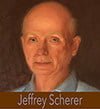
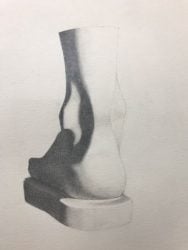
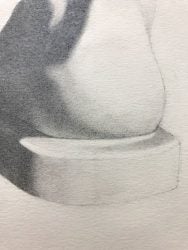
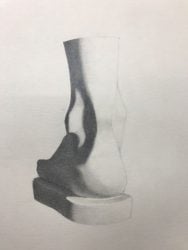

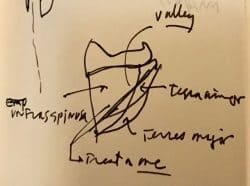
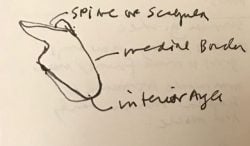
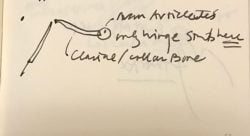
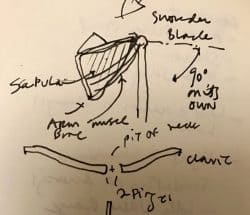

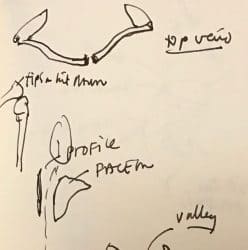
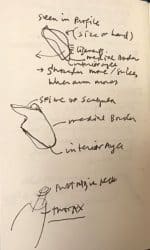
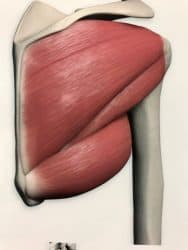
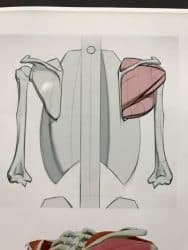
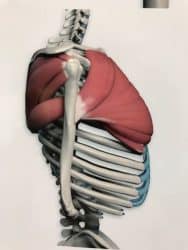
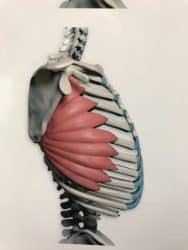
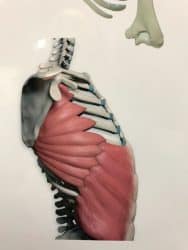
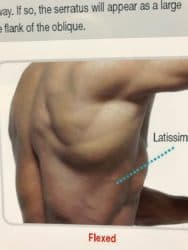
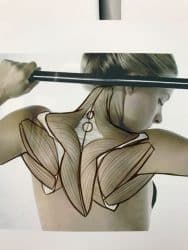
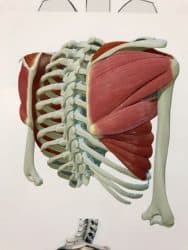
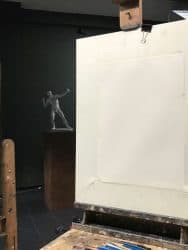
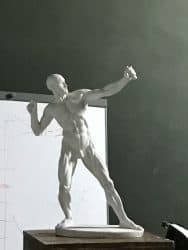
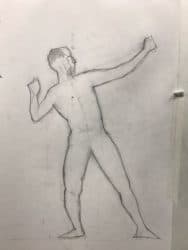
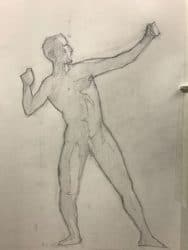
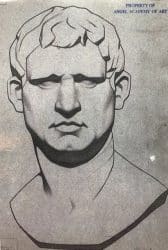

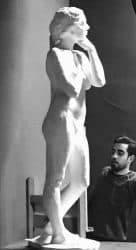


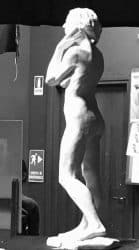
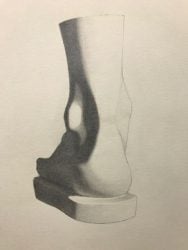
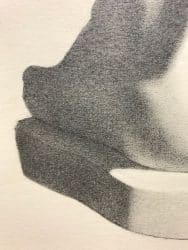

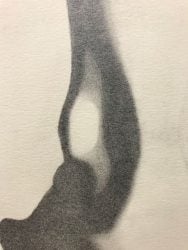

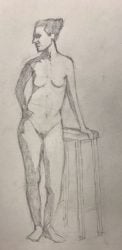
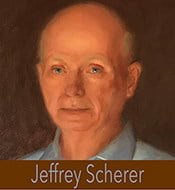
Recent Comments